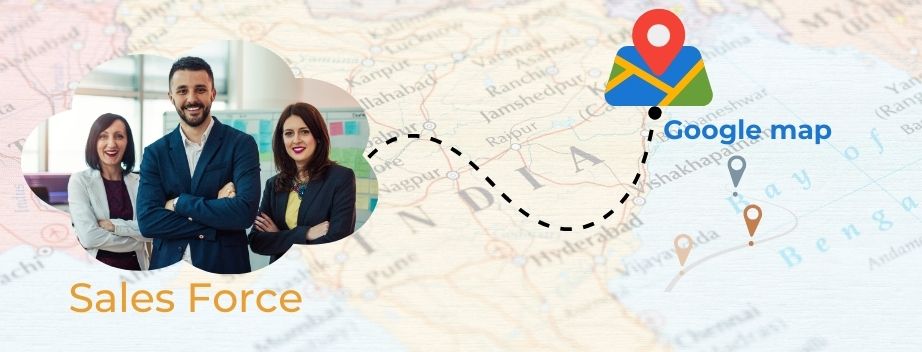
Customers are also finding more uses for adding geography into their salesforce system directly. Google Maps API is a tool provided by Google to enable developers to embed maps, routes or other geographical related services in an application.
Together with the use of the Google Maps API, address data thus easily turns into visual maps as well as actionable location information with the integration of Salesforce. For the sales and service force, this integration provides two distinct benefits: tactical and strategic, from prospect visit scheduling to estimated distance and time.
Google Maps API is an assemblage of strong services and tools that have the ability to place active Maps and location in software.
It embodies geocoding, where one inputs an address to obtain calculated coordinates for that location, reverse geocoding, where one inputs coordinates to get the address of the location, rout ability, where one needs to find out the most probable route between two locations and calculate distance.
With the use of Google Maps API integrate in Salesforce, businesses get to have features of map and location information integration of fields which enable the sales and service representatives to make geographic decisions while working in the CRM.
Maps JavaScript API: Enables putting maps into websites or applications.
Geocoding API: Translates geographical coordinates out of addresses and the other way around.
Distance Matrix API: Determines distances and time for travelling from one location to the other for several places.
Places API: This factory identifies a place and offers sub-information including name, the address, and contact information of the place.
All these elements offer some special value when connected with Salesforce and define the way data is represented and utilized inside the program.
Google Maps API can be integrate and install in Salesforce by following several steps that includes generating API keys to final installing of the map interface in Salesforce. Below is a step-by-step guide for setting up this integration:
Visit Google Cloud Console: To encrypt your data from bottom to top, open the Google Cloud Console at https://console.cloud.google.com/ and sign in to your account.
Create a New Project: To create a new project go to Project on the ribbon, and under the Project tab choose New Project. As with any other project, it is important to give your project a name that will easily be known by all.
Enable the Google Maps API: Visit the API Library and turn on the APIs you will be
using in your project which are Maps JavaScript API, Geocoding API and Distance
Matrix API.
Generate the API Key: After that, go to the Credentials tab in the Cloud Console to
create the API key once the APIs are enabled. This key will be used by salesforce to warn Google that the request to be made is from salesforce.
Restrict the API Key: It is also important to limit this key from a specified domain or IP address in order to enable security.
Create a Custom Field for Google Maps API Key: On Salesforce, set up a custom
setting or the text field to ensure it keeps the Google Maps API key securely.
Enable External Services: Approve the setting up of Salesforce integration service to be able to interact with other external APIs. This could entail changes of parameters of operation within Salesforce to enable it to permit Google API calls.
Create Custom Fields for Address Data: It is also recommended to add extra fields or to check that existing ones correspond to such address fragments as street, city, state, and ZIP code.
Navigate to Visualforce Pages: Ok, in Salesforce navigate to: Setup > Visualforce Pages and then click on New Visualforce Page.
Embedded Google Maps Script: This needs to be done by including the Google Maps JavaScript API together with the used API key in your Visualforce page. Add script for geolocation, map, and marker in HTML code in JavaScript.
Map Data from Salesforce Fields: Apex Controller should be used to query Salesforce record data (Account or Lead for instance addresses) and pass the result to a Visualforce page.
Display the Map: To achieve this set the Visualforce page to render a map with focus point on the supplied address and markers in Salesforce.
Once testing is completed the integration can be pushed into the Production Salesforce instance and if needed end user training on the new integration. Ask users about potential extras that can further enhance the product, for example, about filters targeting the customer and territory or automatic routing suggestions.
Integrating of Google Maps into Salesforce will improve mostly the sales and the service
functions due to the location intelligence that the teams will be able to get which will make them more informed to make >rms decisions. Here’s how this integration benefits each area:
Improved Territory Management: Customer maps can be created by the sales representatives, which can be used to determine areas of concentration. It gives the chance to distribute leads according to the territory and to balance demands between teams of sales managers.
Optimized Route Planning: This means if Google Map is integrated with the Salesforce application, available sales reps will be able to view the best routes to get to different customer places hence improving sales travel times and fuel expenses.
This is especially helpful for field sales teams who attend to numerous clients in a day because one can arrange the best routes for the achievement of efficiency.
Better Lead Conversion: When we can visualize the location of leads and existing clients, it is obvious for the sales departments to focus on highly potential zones and clients. For instance, or where a rep is already in a particular region paying a client, they would be able to quickly identify other leads or prospects in the same region, meaning follow-up visits increase the probability of turning leads into customers.
Enhanced Customer Insights: With the help of Google Maps, customers’ environment, local competition, and market conditions can be revealed. Geographically insight assists the sales reps to come up with their pitches and proposals which suit the regions hence more sale and impacting presentations are delivered.
Efficient Field Service Management: Mobile workers and service teams including field technicians can take advantage of integrated maps to navigate easily to the customers’ premises, identify the correct routes, and minimize disruption time. This results in quicker reactions, increased punctuality regarding meetings and/or appointments, and rational usage of resources in the field services.
Real-Time Location Tracking: Salesforce with Google Maps can help keep track of
service vehicles and field agents – in real time. This makes it possible for the managers to redeploy or channel agents nearby to respond to priority service needs expeditiously rather than experiencing idle times.
Proactive Service Planning: Group teams can use geographic information to determine places or states that need more services or those that frequent service problems. Consequently, we are able to facilitate proper resource management, schedule preventive maintenance visits and identify service requirements all of which improve service delivery, hence improving customer relations.
Enhanced Communication and Updates: Google Maps will help service
representatives share estimated time of arrival to the location and live location of the
service provider with customers waiting for the salesforce Integration service to be attended to; thus, enhancing the level of trust. Technicians having the service window timings helps customers with time of arrival of technicians which makes customers satisfied and loyal.
The combination of Google Maps with Salesforce will help with Ecommerce CRM offers a breakthrough service upgrade to the sales and service division equipped with location intelligence and efficient workflow. From identifying more efficient routes for sales to territory management, real time location tracking for improved service coordination, this integration offers a perfect geographic solution that helps to make better decisions.
Implementing Google Maps API with Salesforce is not only an integration that makes sense but one that brings value through faster, location-specific solutions that create the foundation for customer trust. In the context of evolving forms of work and business in the mobile world with data-centric focus, the combination of Salesforce with Google Maps exists as a valuable tool to enhance performance and effectiveness and thereby change business processes.
 Dhanesh Kumar
Dhanesh Kumar
Copyright @2020. All Rights Reserved by WEB DIGITAL MANTRA IT SERVICES PVT LTD
Post Reviews